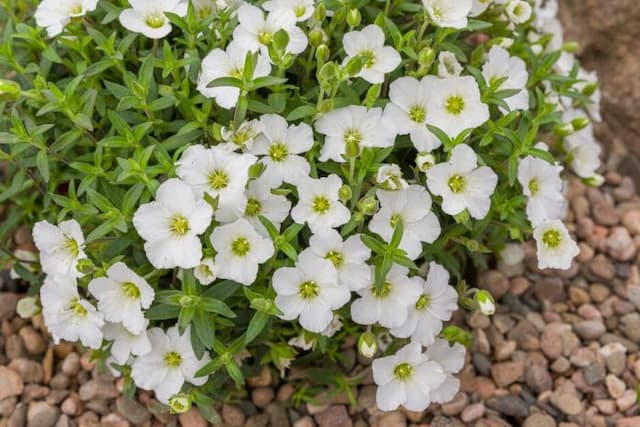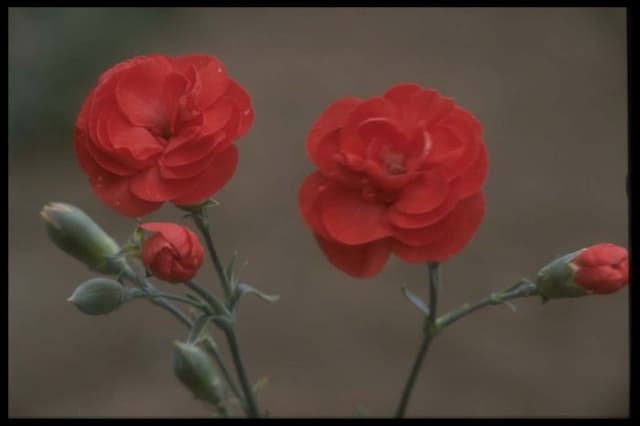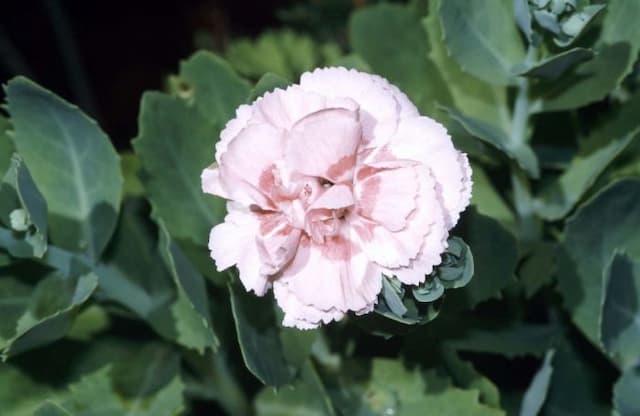Carnation Dianthus 'Oakwood Splendour' (p)

ABOUT
Dianthus 'Oakwood Splendour' is a captivating plant known for its striking flowers and foliage. The blooms are radiant, often featuring a vivid pink hue with intricate patterns. Each flower is adorned with frilled edges, creating a delicate, lacy appearance that adds a touch of sophistication to the garden. The petals can have varying shades, sometimes with darker or lighter accents that highlight their unique texture and form. The center of the flowers is typically marked with a contrasting eye, an enchanting detail that draws the eye and enhances the plant’s overall allure. The foliage of Dianthus 'Oakwood Splendour' is equally impressive. It forms a dense, low-growing cushion or tuft of slender leaves that provide a lush background to the dazzling floral display. The leaves are typically blue-green in color, which complements the vibrancy of the flowers and adds to the plant's palette of cool, soothing tones. The leaves are narrow, with a linear shape that gives the plant a neat and tidy appearance even when it's not in bloom. Together, the flowers and foliage create a spectacular display that can brighten up any garden space. Dianthus 'Oakwood Splendour' is often prized for its long blooming period and its ability to bring both color and fragrance to the landscape. Its delightful scent is another characteristic that makes it a favorite among gardeners and flower enthusiasts. The combination of visual beauty and aromatic pleasure makes this plant a sought-after addition to borders, beds, and containers, where it can be appreciated up close for its ornamental qualities.
About this plant
 Names
NamesFamily
Caryophyllaceae
Synonyms
Oakwood Splendour Pinks, Oakwood Splendour Carnation
Common names
Dianthus 'Oakwood Splendour'
 Toxicity
ToxicityTo humans
Dianthus 'Oakwood Splendour', commonly known as Carnation, is not typically considered toxic to humans. Ingestion of parts of the plant is usually not harmful, but sensitivity varies among individuals, and it can cause mild gastrointestinal discomfort in sensitive people or if consumed in large amounts. There is no specific symptom of poisoning associated with carnations because they are not known to be poisonous to humans.
To pets
Carnation, the common name for Dianthus 'Oakwood Splendour', is generally regarded as non-toxic to pets. However, individual pets may have varying degrees of sensitivity. Ingestion can at times lead to mild gastrointestinal upset, such as vomiting or diarrhea, particularly if ingested in large quantities. The toxicity is typically low, and resulting health issues from ingestion are usually minor and do not require medical treatment.
 Characteristics
CharacteristicsLife cycle
Perennials
Foliage type
Evergreen
Color of leaves
Blue-green
Flower color
Pink
Height
1 foot (30 cm)
Spread
1 foot (30 cm)
Plant type
Herb
Hardiness zones
5
Native area
Europe
Benefits
 General Benefits
General Benefits- Aesthetic Appeal: Adds vibrant color and visual interest to gardens and landscapes with its striking flowers.
- Attracts Pollinators: Invites beneficial insects like bees and butterflies, supporting local ecosystems.
- Fragrance: Offers a pleasant scent that can enhance the sensory experience of a garden.
- Low Maintenance: Requires minimal care once established, making it a hassle-free choice for gardeners.
- Drought Tolerance: Capable of withstanding dry conditions, reducing the need for frequent watering.
- Cold Hardy: Can survive in cooler temperatures, allowing for a wide range of growing zones.
- Versatility: Suitable for borders, rock gardens, and containers, providing flexibility in garden design.
- Long Blooming: Produces flowers for an extended period, ensuring a lasting display of color.
 Medical Properties
Medical PropertiesThis plant is not used for medical purposes.
 Air-purifying Qualities
Air-purifying QualitiesThis plant is not specifically known for air purifying qualities.
 Other Uses
Other Uses- Culinary Garnish: The vibrant petals of Dianthus can be used to add a splash of color to salads and desserts, though it's essential to ensure the flowers are free from pesticides and are indeed the edible variety.
- Natural Dye: The bright blooms can be used to create natural dyes for fabrics and papers, giving them a unique and organic hue.
- Artistic inspiration: Artists can use the striking appearance of Dianthus as inspiration for paintings, drawings, and other forms of visual art.
- Photography Enhancement: Dianthus flowers can provide a photogenic addition to enhance the composition and subject matter in photography.
- Perfumery: The distinctive scent of Dianthus flowers can be used in the creation of perfumes and scented products.
- Crafting: Dianthus flowers can be dried and used in various crafting projects, such as making potpourri or floral arrangements.
- Candle Making: The scent and petals of Dianthus can be incorporated into the wax of homemade candles for a floral touch.
- Scented Stationery: Dried Dianthus petals can be infused into paper products to create scented stationery for a personalized touch.
- Educational Tool: Dianthus plants can be used in educational settings to teach about plant biology, horticulture, and pollinator attraction.
- Theme Gardens: Dianthus can be a part of themed gardens, such as a Victorian or cottage-style garden, to provide authenticity due to its historical popularity.
Interesting Facts
 Feng Shui
Feng ShuiThe Carnation is not used in Feng Shui practice.
 Zodiac Sign Compitability
Zodiac Sign CompitabilityThe Carnation is not used in astrology practice.
 Plant Symbolism
Plant Symbolism- Love: The genus Dianthus is often associated with love and admiration, which stems from its name "Dianthus" - a combination of the Greek words for divine ("dios") and flower ("anthos"). This particular variety, with its rich and vibrant colors, exemplifies heartfelt affection.
- Passion: The intense colors of the 'Oakwood Splendour' represent deep feelings and a strong-willed nature, often linked to passionate emotions and a vibrant spirit.
- Purity: Traditionally, Dianthus flowers are also symbolic of purity and the innocence of a young love. This variety, with its striking appearance, suggests a pure and unwavering feeling.
- Boldness: The 'Oakwood Splendour's' prominent and bright appearance can symbolize boldness or making a statement, as it stands out elegantly in any garden setting.
 Water
WaterCarnation 'Oakwood Splendour' should be watered thoroughly, but the frequency depends on soil conditions and climate. For plants in the ground, a general rule is to water them with about 1 to 1.5 gallons per plant every week during the growing season, ensuring that the water penetrates deeply into the soil. However, during hot and dry spells, you might need to water more frequently, while during periods of rain, less water may be needed. It's essential to avoid overhead watering to keep the foliage dry and prevent fungal diseases. Always check the top inch of the soil before watering; if it feels dry, it's time to water.
 Light
LightCarnations, including 'Oakwood Splendour', thrive in full sun conditions. They need at least six hours of direct sunlight daily to develop their full bloom potential. Planting them in a spot that receives unfiltered sunlight for most of the day will ensure healthy growth and plentiful flowers.
 Temperature
TemperatureCarnations like 'Oakwood Splendour' prefer a temperate climate and do well in a temperature range between 40°F and 75°F. They can survive short periods of colder temperatures down to about 20°F and can handle heat up to 85°F, but prolonged exposure outside of their comfort zone can be harmful. The ideal growing conditions include daytime temperatures around 60°F to 70°F and slightly cooler temperatures at night.
 Pruning
PruningPruning carnations like 'Oakwood Splendour' is essential for maintaining a compact shape, encouraging bushy growth, and promoting vigorous blooming. Deadhead spent flowers regularly to encourage new blooms, and after the main flowering season, cut back the stems to about one-third of their height to stimulate a second blooming period. The best time for heavier pruning is early spring or after the plant has finished most of its blooming cycle.
 Cleaning
CleaningAs needed
 Soil
SoilThe best soil mix for the carnation 'Oakwood Splendour' should be light, well-draining, and fertile with a neutral to slightly alkaline pH ranging from 6.7 to 7.5. A combination of loam, compost, and a small amount of sand or perlite to improve drainage can be ideal. Regular feeding with balanced fertilizer will support vibrant blooms.
 Repotting
RepottingCarnations, such as 'Oakwood Splendour', typically require repotting every 1-2 years or when they outgrow their pots. Repotting in the spring helps the plant recover faster and ensures it has room for new growth, preparing it for a prosperous blooming season.
 Humidity & Misting
Humidity & MistingCarnations like 'Oakwood Splendour' prefer moderate humidity levels, but they are quite adaptable and can tolerate a range from low to high humidity as long as they have good air circulation and are not left in stagnant, moist conditions that could lead to fungal diseases.
 Suitable locations
Suitable locationsIndoor
Ensure full sun, good air flow and regular deadheading.
Outdoor
Full sun, well-drained soil, protect from severe winter.
Hardiness zone
3-9 USDA
 Life cycle
Life cycleThe life cycle of Dianthus 'Oakwood Splendour', commonly known as pinks, begins with seed germination which occurs in spring or early summer under ideal conditions of mild temperatures and moist soil. The seedlings develop true leaves and a root system, establishing themselves as young plants. As they mature, Dianthus 'Oakwood Splendour' produces dense tufts of blue-green foliage and, by late spring to early summer of the following year, they start producing their characteristic fragrant flowers with frilled edges, which can be various shades of pink, red, or white. After pollination, typically by insects, the flowers develop into capsules containing numerous small seeds. The parent plant may remain alive for several years, going through repeated flowering and seed-set periods, typically forming a mounding habit. As a perennial, it may undergo periods of dormancy in winter, especially in colder climates, before resprouting in the spring to continue its cycle.
 Propogation
PropogationPropogation time
Spring to early summer
Dianthus 'Oakwood Splendour', commonly known as pinks, is typically propagated through cuttings. This is a straightforward method that allows gardeners to produce identical clones of the parent plant. To propagate pinks by cuttings, one should select a healthy, non-flowering stem and cut a 3 to 4 inch (approximately 7.5 to 10 cm) piece just below a node, where the concentration of growth hormones is high. This cutting should then have its lower leaves removed and be dipped in rooting hormone powder to encourage root development. The prepared cutting is then placed in a well-draining soil mix, ensuring that the node where the leaves were removed is buried in the soil. The cutting requires consistent moisture and should be kept in a bright area without direct sunlight until roots have formed, which usually takes a few weeks. After root establishment, the new pinks plant can be transplanted to a desired location in the garden.



![Pink [Tequila Sunrise]](/_next/image?url=https%3A%2F%2Fplants-admin.emdemapps.com%2Fimages%2Fplants%2F%2Fimages%2F604b5d995d06e.png&w=640&q=75)





